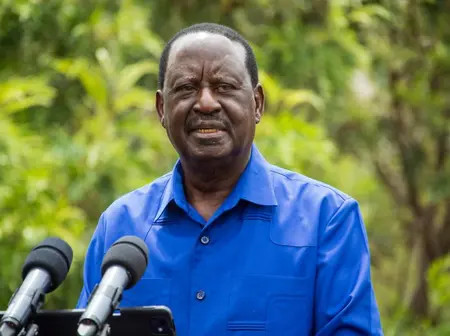Questions have surfaced on whether or not former Prime Minister Raila Odinga’s social media account may have been compromised after a post announcing the launch of a national digital coin on Thursday, September 18, was deleted.
The development has fueled speculation on whether his account was hacked or if it ties into the launch of the digital asset.
A post from Raila’s verified X account shared a message and a deepfake video unveiling “Kenya Token,” presented as the nation’s official step into cryptocurrency.
“We are pleased to announce that the Kenya Token will soon launch. A new digital asset aimed at improving our financial system and supporting economic growth. Kenya is stepping up to lead Africa into the crypto revolution, embracing digital finance and shaping a more crypto-friendly future. The Official token will be launched on Solana,” the clip captured him saying.
“As the former Prime Minister of the Republic of Kenya, I am proud to announce that we will soon launch a new digital coin, an ambitious step towards strengthening financial systems and supporting sustainable economic growth across Kenya, Africa, and the rest of the world.
“Kenya is ready to embrace the future. The Kenya Token will position our nation at the forefront of Africa’s crypto revolution,” he added.
Some Kenyans quickly pointed out the deception in the AI-generated video, referencing official written statements from credible government sources that dismissed its authenticity.
Initially, Odinga’s apparent endorsement of the digital coin looked convincing since it came from his verified account and carried his image. Reports—though unverified—suggested that nearly 20 per cent of the token’s supply was purchased shortly after the deepfake video surfaced.
Although the clip was later removed, the episode highlighted how deeply crypto scams have infiltrated social media, particularly on X.
The Odinga deepfake emerged about six weeks after ICT Cabinet Secretary William Kabogo also appeared to endorse the same cryptocurrency in a July 11 social media post, claiming it aligned with Kenya’s push for technological growth.
“I welcome the launch of the Kenya Digital Token as a bold private sector step to expand our digital economy. Though not a government initiative, it aligns with our policy framework for virtual assets and supports our vision of a transparent, secure, and well-regulated ecosystem.
“Crucially, it speaks to the bottom-up economic transformation agenda by empowering youth, fostering inclusion, and driving innovation. If structured responsibly, the Kenya Digital Token can unlock opportunities in micro-investment, community value creation, and digital engagement, particularly in underserved regions,” he said.
The similarities between Raila’s pulled-down post and Kabogo’s endorsement of the coin have stirred heated discussion. The big question remains: was Raila’s account truly hacked, or was it intentionally used to promote the project?
Deepfakes have become increasingly difficult to detect as artificial intelligence (AI) and machine learning models rapidly advance.
Modern algorithms can replicate facial expressions, voice tones, and even subtle mannerisms with alarming accuracy, making manipulated videos appear authentic. In this case, the video of Raila was made to be so authentic that it was treated as credible information and even picked up by reputable media houses.
High-resolution rendering and improved synchronisation of audio and visuals further blur the line between real and fake. Unlike earlier versions that showed obvious glitches, today’s deepfakes can bypass casual scrutiny, tricking even tech-savvy viewers.
Social media amplifies the challenge, spreading these clips before verification. Without robust detection tools and digital literacy, distinguishing genuine content from fabricated media is becoming more complicated than ever.

Leave a Reply